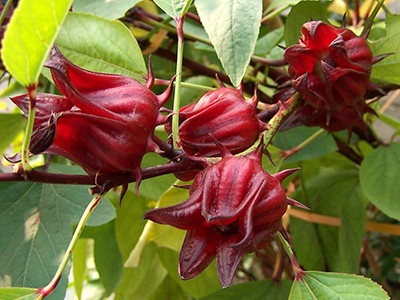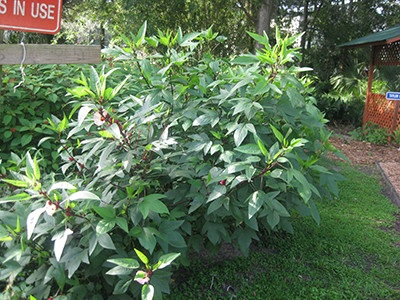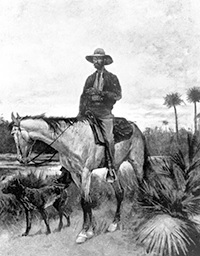Roselle
From
Gardening Solutions
Florida Cooperative Extension Service Institute of Food and
Agricultural Sciences, University of Florida
Looking for something a little different for the garden? Why not try
roselle? A relative of hibiscus and okra, this plant was once a very
popular edible. While not native to the state, it seems that most
Florida Cracker homesteads grew it.
Roselle (Hibiscus
sabdariffa) is also called Florida cranberry, red
sorrel, or Jamaica sorrel, although it is actually native to Central
and West Africa and is grown around the world. The part of the plant
that is edible are the calyces of the roselle flower which can be used
to make a variety of jams, sauces, and teas.

Roselle calyces
Characteristics
Roselle
produces attractive foliage and flowers and will reach a height of
about 7 feet. Many parts of the plant, including the seeds, leaves,
fruits, and roots, are used medicinally or in foods. The leaves are
lobed and reddish-green and can be used as a cooked green or added raw
for a nice "zing" to a salad. Appearing in October, the flowers are
typically yellow with a dark center and about 3 inches wide. The part
of the plant most popular however, is found at the bottom of each
flower. This fleshy, bright red cup-like structure contains the plant's
seeds and is called a calyx. The color and tart taste of the calyces
makes them a good replacement for cranberries.
In the Caribbean,
roselle is used to make a festive Christmas drink. Bakers can
substitute roselle for rhubarb when making a fruit crisp or pie. The
seeds, which are high in protein, can be roasted and brewed like
coffee, or ground and added to soups and salads. The nutrient-rich
calyces can either be stored frozen or dried for making cordials,
punches, and jams. The calyces can also be used to add color and flavor
to herb teas. Be sure to harvest calyces before they turn brown on the
plant and separate them from the seeds before using them in recipes.
Florida
"Cranberry"
Sauce
Roselle
can be used to make a cranberry sauce alternative. Try using chopped
roselle calyces in place of cranberries. Sauces should kept
refrigerated and consumed within a few days.
Planting and
Care
Roselle
is started from seed or cuttings and typically planted outdoors in
April or May. The variety 'Victor' has proven to be a good choice for
gardeners in South Florida. Early pruning will increase branching and
the development of more flowering shoots.
Plants begin to bloom
as the days shorten (in 4-5 months) and the calyces are ready for
harvest in October or November. Calyces should be harvested when they
are tender and plump; they will stay fresh for about a week after
picking. Harvesting encourages more flower buds to develop. You won't
have to plant a lot of roselle to get a good harvest; one plant will
give you many fruits—as much as 12 pounds with the right care.
Roselle
does best in well-drained soil and appreciates watering when rainfall
is inadequate. Be aware that this plant does not do well in the shade
and needs plenty of sunlight to thrive. Roselle can also be planted in
Florida in August. It is only hardy in zones 9-10, and is damaged by
frosts or freezes; plan your harvest before temperatures drop below 40°
F. Root-knot nematodes are the major pest you will have to deal with
when growing roselle, so be sure to practice crop rotation to reduce
nematode problems.
Since roselle grows as an annual, be sure to
save seeds from one season to the next. It is an heirloom plant that is
passed from gardener to gardener. You can also look for plants in the
spring and summer at your local farmers market.

Roselle plant
For more information on roselle, contact your county Extension office.
UF/IFAS
Publication
Roselle, Hibiscus
sabdariffa L. https://edis.ifas.ufl.edu/mv126
Elsewhere on
the Web
Cooking
with Roselle (from Production of Roselle by James H. Beattie, UNT
Digital Library)
https://digital.library.unt.edu/ark:/67531/metadc9193/m1/4/
Florida
Cracker

"Cracker Cowboy"
Unfamiliar
with the term "Florida Cracker"? The Cracker Cowboys of Florida were
colonial-era settlers, often of Scots-Irish descent. The term Cracker
in Florida usage relates to the whip these "cow hunters" used to herd
cattle in Central Florida.
To learn more, we recommend A Land
Remembered by Patrick D. Smith. The story of three generations of a
pioneer family in Florida, A Land Remembered was winner of the Florida
Historical Society's Tebeau Prize as the Most Outstanding Florida
Historical Novel.
Back to
Roselle Page
|
|